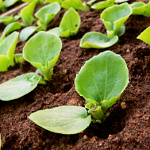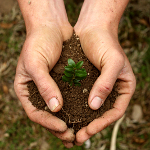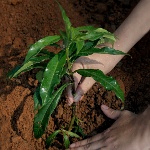How-to Get Started Composting
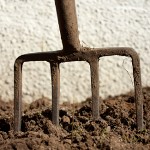
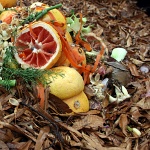
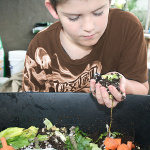
Choosing a site
 The first thing you need to do is choose a site for your compost bin or heap.
The first thing you need to do is choose a site for your compost bin or heap.
Exactly where you put it will depend on the size and layout of your garden. It needs to be convenient and accessible so you can use it regularly but not in the way where it’ll annoy you (ie, not in the middle of the lawn!).
Ideally, it should be on bare soil or grass rather than on concrete or the patio. This will help drainage of excess water – this is particularly important if you don’t have a lid on it to keep out the rain. (If you have to put it on a solid base, place a layer of twigs and sticks at the bottom to keep the rest of the compost off the ground and allow for drainage.)
If you can put it in a sometimes sunny spot, that’s a bonus but not essential. If sun is limited in your garden, it’ll be better to use the space for flowers or a deckchair than your compost heap! If your garden is always very sunny, you may find that you have to work hard to keep it moist (see “Fine tuning” below).
Compost heap or bin?
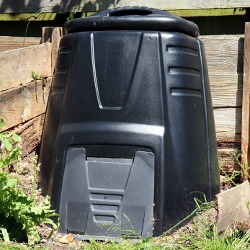 It’s up to you whether you have an open compost heap, a purpose-bought bin or something you’ve cobbled together yourself.
It’s up to you whether you have an open compost heap, a purpose-bought bin or something you’ve cobbled together yourself.
Each type of heap or bin has its own advantages and disadvantages but for a beginner, it’s probably easiest to start with a purpose-bought bin. Your local council (or strangely, water company) may sell them more cheaply than shops.
A kitchen caddy
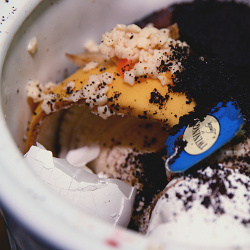 Even if your bin is right next to your door, you’ll probably want a kitchen caddy for collecting scraps and other kitchen waste rather than taking every potato peeling to the compost bin individually!
Even if your bin is right next to your door, you’ll probably want a kitchen caddy for collecting scraps and other kitchen waste rather than taking every potato peeling to the compost bin individually!
An old ice cream tub or similar is fine (we use a mushroom box from the supermarket) or a cardboard cereal box if your scraps aren’t too soggy. You can buy dedicated kitchen composting caddies or “bio bags” – the only difference is they’re prettier and cost money!
What to compost
Now you’re ready to start composting – perhaps you’re wondering what you can and can’t put into your bin? Just search our site and see!
You can compost all sorts of stuff but to get started, compost:
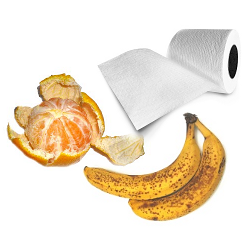
- Veg and fruit peelings, leftovers & expired juice
- Teabags & coffee grounds
- Crushed up egg shells
- Cardboard like toilet rolls, egg boxes and cereal boxes
- Newspaper
- Dead flowers & plants
- Garden clippings
- More things to compost!
Don’t compost any meat or dairy products, very glossy paper (like magazines), aggressive plants/weeds from the garden (like ivy & bindweed) or dog/cat poo.
The average household produces a considerably amount of compostable material each week – as you keep adding new matter to the top, the stuff lower down the pile will begin to breakdown into compost. We found we couldn’t fill our bin with kitchen/household waste – it was breakdown down as fast as we were filling it!
Using your compost
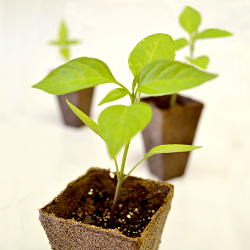 At its most basic, that’s composting. Fill up your bin and leave it for a few months and you’ll have compost!
At its most basic, that’s composting. Fill up your bin and leave it for a few months and you’ll have compost!
Most basic bins or heaps need 6-12 months to breakdown properly but if you’re filling it quite slowly, you’ll be able to start using stuff from the bottom while still adding new stuff to the top.
If you’ve bought a composting bin, there will probably be an “access hatch” at the bottom to help you get to the lovely compost and/or check on its progress.
Use a spade or fork to dig it out and then dig it into your flower or veg beds. Don’t worry if you can still see bits of egg shell, cardboard or small twigs – that stuff will keep breaking down in the soil, and will also help aerated heavy soils.
And that’s composting! Scraps and household waste go in, lovely rich soil comes out, hurrah!
Fine tuning
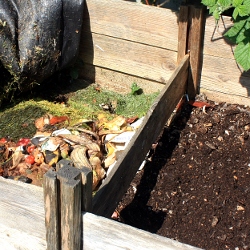 That’s really all you need to do to compost – put stuff in the bin then wait. But it’ll rot down quicker though if you fine tune things a little.
That’s really all you need to do to compost – put stuff in the bin then wait. But it’ll rot down quicker though if you fine tune things a little.
Good compost piles are warm, moist and balanced.
The warmth is generated by the decomposition process – and things decompose faster if they’re warm: keep the heat in by using a lid on the bin if you’ve got one.
Moisture makes things decompose faster too – it shouldn’t be wet-wet but not dry either. Add the dregs from the tea pot or the coffee maker, expired fruit juice, the water from boiling veg, that plant pot that filled up with rain the other day…
Finally, by balanced, we mean add a mixture of stuff rather than just one thing (or one type of thing). In the composting world, we talk about “greens” and “browns” – greens are basically fresh things (veg peelings, grass clippings) and browns are drier and bulkier (cardboard, dry leaves). All veg peelings or grass clippings would compact quickly, cutting off air and slowing down decomposition. All cardboard would take ages to rot down because it is so dry, and the resulting compost wouldn’t be very rich at all. There is science behind it but basically, if you keep adding a mixture of things, you’ll be fine.
